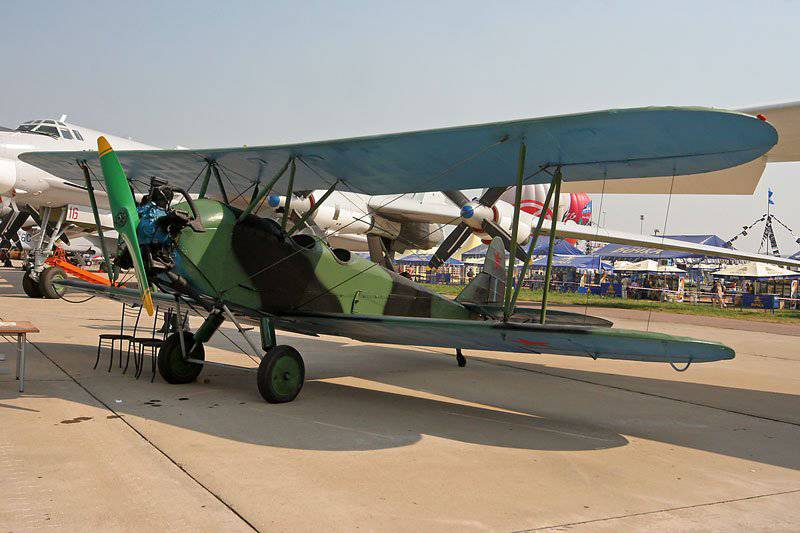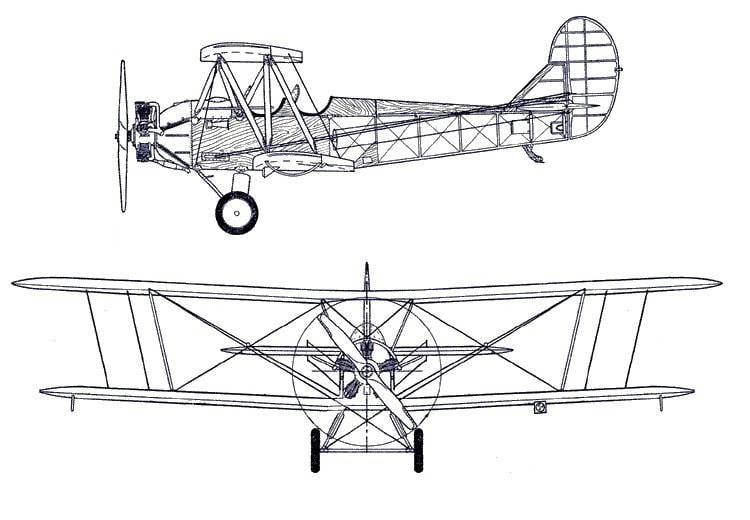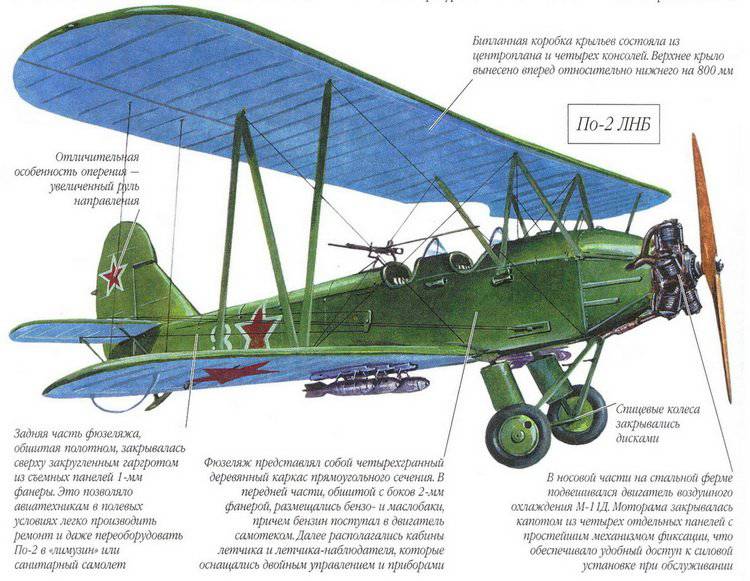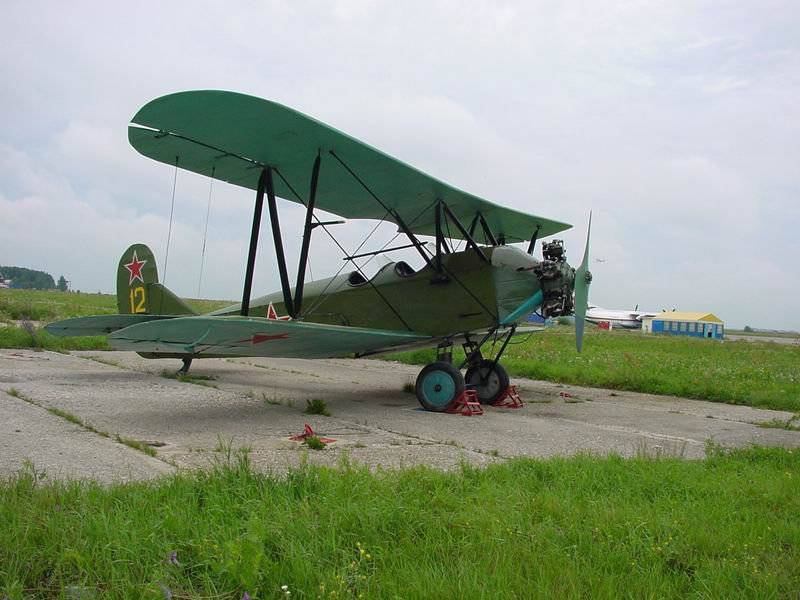Aviation of the Red Army of the Great Patriotic War (part of 2) - training and multi-purpose aircraft U-2 (Po-2)
In its layout scheme, the U-2 was a typical biplane. Its design was dominated by wood and linen sheathing. The aircraft was equipped with an air-cooled engine M-11, which developed a power of 100 hp. Like the aircraft, the M-11 engine was extremely successful. For almost 20 years, he was the main and almost the only engine for light motor aviationcreated in the USSR. At the same time, the U-2 (Po-2) was developed not only as a training machine. He had many fairly varied options, differing in their purpose. Among them we can distinguish agricultural, staff, communications, sanitary, passenger, for aerial photography, float and other versions.
During the Great Patriotic War, many of these biplanes were converted into a light night bomber, which took to the flight to 300 kg. bombs. A rifle point with a machine gun was equipped in the rear cabin of this aircraft, which received the designation U-2ВС. On the fronts operated several aviation regiments armed with these machines. They made their flights at night, striking harassing bombing blows at the enemy’s immediate rear and at its leading edge.

Description of the design of the Y-2 (Po-2)
The design of the aircraft U-2 was wooden and was made of pine and plywood, with linen trim. The units of the construction were made of mild steel, the wings of the wing box were first made of duralumin drop-shaped pipes, but were soon replaced with round steel pipes to which wooden fairings were taped with glue on the glue (to reduce the cost of the entire structure). The fuselage of the aircraft had a front plywood part and a bracing tail; the upper edge of the rear part was covered with a removable convex gargot made of 1-mm plywood for ease of inspection. The motor frame was initially in the form of a ring and was made by stamping from 4-mm duralumin. But since 1931, it has been replaced with all-welded steel pipes.
The wings of the Y-2 were normal, two-spar with the profile of TsAGI-541 and relative thickness 8,1%, with the lower edge. Ribs - with plywood wall and slats-shelves without grooves, spars - box-shaped. Reiki were attached to plywood with nails and glue, only casein glue was used in production. The aircraft stabilizer was also dvuhlonzheronnym, the angle of its installation could be changed on the ground with the help of rearrangement of the rear fork bolt, which was located on the comb of the keel side member. All rims and wings of the U-2 were made of duralumin. The stabilizer struts were made of steel pipes.
The biplane chassis consisted of a front and rear strut, as well as a pair of ribbon braces and an axis. The rear struts were depreciated and were made of telescopic tubes with cross-arms, on which an 13-mm rubber cord was wound (16 meters for each strut). The wheels of the aircraft were spoke and had the size 700 on 120 mm. The crutch was made of ash and was oriented. It was driven together with the rudder through coil springs. The control wiring was cable, on straight sections - wire. Skis could be installed on the plane for operation in the winter. The main skis had size 2200х334х264 mm., Tail ski - 500х204 mm.

Initially, the engine hood covered the entire crankcase, but then was changed. The entire engine, starting from the rear wall of the crankcase, was left open, and the hood was reduced to separate walls 4, which were fixed on special loops-combs along the rear edge and tightened with a cable with a spring and a lock on the front edge around the engine mount. At the same time, the hood can close and open almost instantly, which greatly facilitates the maintenance of the engine. In winter, the crankcase could hide behind a simplified hood.
The flight qualities of the aircraft depended heavily on the purpose of its use, as well as on what changes were made to its equipment. At the same time, in all its versions, the aircraft was distinguished by excellent reliability, was very docile and easy to operate. The U-2 aircraft could easily fly from the smallest airfields or even unprepared sites for this. The run-up was only 100-150 meters. The mass of the empty aircraft in the training version was only about 650 kg., In other versions - 750 kg. Take-off weight ranged from 890 to 1100 kg., With a bomb load reached 1400 kg. The maximum speed of the aircraft was 150 km / h, cruising speed was considered at the level of 100-120 km / h, landing speed was equal to 60-70 km / h. The maximum flight ceiling was equal to 3800 meters.
U-2 aircraft application (Po-2)
For many years, this aircraft remained the only car in its class, which was used for initial training in Osoaviahima flying clubs and flight schools. The educational organizations of the Defense Society on the U-2 aircraft during the war years were able to prepare almost 100 000 new pilots, which, of course, made a significant contribution to the victory in the war.

Y-2 took off on January 7 1928 of the year. Originally created as a training aircraft, he was able to acquire many additional tasks and functions over the next decade. In the first flight, this aircraft was piloted by the famous Soviet test pilot Mikhail Gromov. Although the military initially intended to use the U-2BC as a light combat aircraft, by the end of the 1930s it was more used in the Air Force as a training vehicle. On it, the crews could practice the skills of bombing, aerial photography and air shooting.
Already in the first few weeks of the war with Germany, the biplanes U-2 of various modifications were used to solve a wide range of tasks for which they were not intended. The effectiveness of this training machine turned out to be so great that later on throughout the war the U-2 / Po-2 was constantly modernized and refined, primarily to expand its combat capabilities. At the very beginning of the Great Patriotic War, the USSR faced a nightmare of retreat and lost frontier battles, as well as the evacuation of the largest vital military factories inland. Under these conditions, a light training biplane Y-2 came at an opportune moment.
Received improvised weapons, these aircraft from the flying clubs and flight schools were shipped to various combat units. Later, all these planes were reduced to separate special units, which later became shelves of light night bombers. The light, low-speed U-2 aircraft, practically deprived of protection, suffered heavy losses during day operations. But despite this, at the initial stage of the war, some commanders set themselves suicidal tasks for the units armed with this aircraft, which led to huge losses in people and equipment, extracting minimal benefits from this. After the situation on the fronts leveled off, the units armed with the U-2 completely switched over to night bombardments. The constant raids of these small bombers undermined the morale of the German units, not giving them any rest or sleep at night. The Germans themselves called the plane “a sewing machine” or a “coffee grinder,” which broke the silence of the night with explosive bombs.

“These planes do not allow us to live - we cannot start a fire either in a small fire or in a stove - the crews of U-2 immediately discover them and drop bombs. They find us constantly, because of this we have to sit in trenches all night long in order to avoid unnecessary losses, ”wrote a Wehrmacht veteran. Soviet night bombers U-2 began its work at dusk. At low altitude, the aircraft flew from their bases to small aerodromes of a jump, which were located almost at the very front line. Here weapons were loaded on airplanes, and they rose into the night sky in order to deliver bombing attacks on German positions. The proximity of the airfields jump to the front allowed during the night to make several sorties. There are cases when Y-2 took off overnight before 10 times. If you multiply this number by the maximum bomb load, which was equal to 300 kg., It turns out that a small, low-speed biplane per night could drop more bombs on the German position than a heavy bomber.
Most often, the U-2 aircraft were used in pairs. The first plane was planning on a target with a motor that worked at low speeds or was completely stopped in order to fully use the surprise factor and to avoid shelling by anti-aircraft guns. At this time, the second bomber came to the target from the flank, perpendicular to the direction of attack leading to the already lit, and if lucky, the burning target. At the same time, on their bitter experience, the Germans were convinced of the low effectiveness of anti-aircraft fire, which only allowed an airplane hiding in the darkness to more accurately perform bombing. At the very end of the war, the desperate Germans even tried to copy the Soviet tactics of the “disturbing” night bombardments, creating their own combat units that were armed with Go XT Go 145C aircraft.
The flight record of navigator I. A. Shchedrin from the 596 NBAP (night bomber air regiment), which made hundreds of sorties on the Stalingrad front 1 from 31 to 1942 in December, can indicate the intensity of the use of these aircraft during the war. In August, 4, in the midst of the battle for Donbass, regular night raids of U-1943 bombers on the important railway junction Ouspenskaya reduced its carrying capacity immediately by 2%. The Germans completely stopped the night transportation of goods, fearing the complete failure of this station. In total, about 50 regiments and squadrons armed with U-60 / Po-2 took part in the fighting, among which a special place was occupied by the 2 Guards Taman NBAP, fully staffed with female pilots.
Information sources:
-http: //www.airpages.ru/ru/u-2.shtml
-http: //www.airwar.ru/enc/other1/u2.html
-http: //pro-samolet.ru/samolety-sssr-ww2/trening/90-u-2
This film tells about the training, transport and multipurpose aircraft of the USSR of the thirties and forties. You will learn about the P-5 scout, the Ut-2 training aircraft, the Li-2 transports and the B-2 bombers, as well as the simplest and safest, but terrified, Wehrmacht soldiers, the multipurpose U-2 aircraft (Po-XNX ).
Information